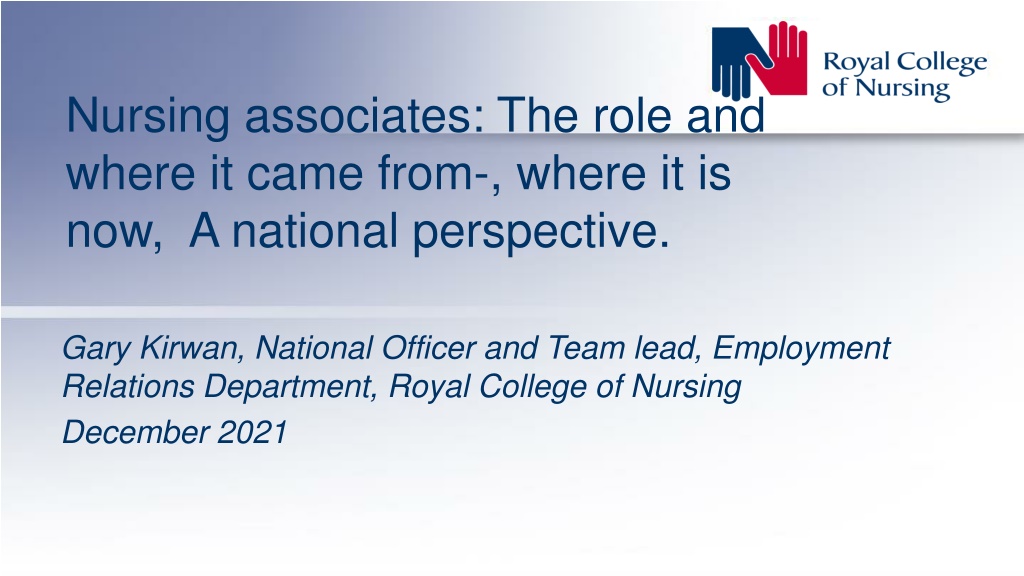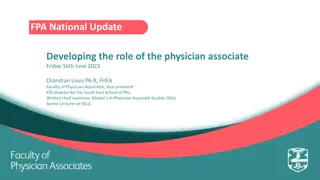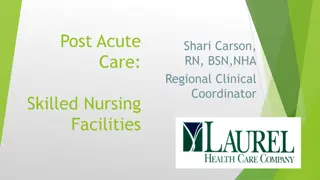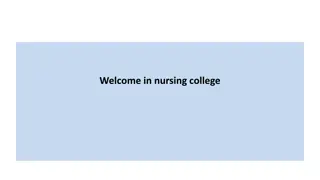Nursing Associates: Evolution and Impact on Healthcare
Exploring the journey of Nursing Associates from inception to their current role in the healthcare sector. The article discusses the origins of Nursing Associates, their training programs, regulatory aspects, and their increasing presence in both NHS and social care settings. Emphasis is placed on the transition of Nursing Associates to Registered Nurses through top-up degree programs. Challenges and opportunities faced by Nursing Associates are also highlighted, showcasing their vital contribution to the healthcare workforce.
Download Presentation

Please find below an Image/Link to download the presentation.
The content on the website is provided AS IS for your information and personal use only. It may not be sold, licensed, or shared on other websites without obtaining consent from the author. Download presentation by click this link. If you encounter any issues during the download, it is possible that the publisher has removed the file from their server.
E N D
Presentation Transcript
Nursing associates: The role and where it came from-, where it is now, A national perspective. Gary Kirwan, National Officer and Team lead, Employment Relations Department, Royal College of Nursing December 2021
The Story so far- Nursing Associates Employer driven - rooted in the Shape of Care review Health Education England led initially, now responsibility for standards is with NMC England only role Nursing Associate 2 year programme, an apprenticeship since 2018 First and second cohorts recruited to in 2017, before apprenticeship developed NAs qualified in 2019 from the 2017 cohort Pattern of recruitment across STP, now ICS s areas, all sectors involved
Nursing Associates, pay and Job evaluation banding There are two roles; Trainee Band 3, Nursing Associate Band 4, pending job evaluation (Band 3 agreed, after job evaluation). Are employers Job evaluating the Job descriptions, are the results a band 4? TNAs are apprentices, negotiations on apprenticeship pay, for all apprenticeships in the NHS, under the NHS Staff Council, for those employed in the NHS.
NMC regulation First NAs regulated with NMC in 2019 England-only role National standards for education National NA proficiencies to be met on qualification Generic not field specific One code for nurses, midwives & NAs Consistent processes for NMC fees, revalidation.
Nursing Associates now Sept 2021 5509 on the NMC register Employer Training Grant: Nursing Associate/Assistant Practitioner to Registered Nurse two year top up degree- commenced Oct 2020 TNA Apprenticeships supported financially via HEE, unlike other apprenticeships Challenges still in social care- work being done by Skills for Care to support TNAs and employers
Nursing Associates now Growing numbers in social care, needs upscaling Primary care, still small numbers Embedded in workplaces NHS White paper and Integrated Care services (2021)- Nursing Associate a key role in the workforce Working to deliver on Covid19 vaccination programme
Governance and Assurance Systems Regulators - NHSi and CQC CQC state - it is important to understand that nursing associates are not registered nurses and we expect health and care providers to consider this when deploying them The Employer - what's in the Job description, how will NAs be deployed, where is training and CPD support? NHS Improvement- resource for deployment of NAs Regulated professional - The Nursing Associate will be expected to work within NMC code
Comparison: Registered Nurse to Nursing Associate NMC Standards of Proficiency RN NA Being an accountable professional Promoting health and preventing ill health Assessing needs and planning care Providing and evaluating care Leading and managing nursing care and working in teams Improving safety and quality of care Coordinating care Being an accountable professional Promoting health and preventing ill health Provide and monitor care Working in teams Improving safety and quality of care Contributing to integrated care
Accountability & delegation: firm ground NMC Code NMC Proficiencies NMC delegation & accountability supplementary info Job descriptions Organisational policies, protocols. Do employers have them? They should
Comparison: Assistant Practitioner and Nursing Associate Assistant practitioner Nursing associate Commenced 2017 Nursing support role Generalist role (not field specific) Regulated by NMC Apprenticeship Level 5 (foundation degree) Progression to registered nurse training explicit National proficiencies and education standards National job description templates/guidance Health economy planning & national targets Commenced 2002 Nursing and AHP support role Defined role/area of practice Not regulated Apprenticeship Level 5 (foundation degree) Progression to registered nurse training variable Local curricula Local job descriptions Local workforce planning
Workforce planning, preparation & deployment (local system): Resources: Skills for health list of apprenticeships in health: https://haso.skillsforhealth.org.uk/standards/#standard-1894 NMC Standards: NAs, RNs, student supervision & assessment https://www.nmc.org.uk/standards/ RCN website, practice based learning: https://www.rcn.org.uk/news-and- events/blogs/practice-based-learning-is-changing NMC protected learning: https://www.nmc.org.uk/globalassets/sitedocuments/education- standards/nursing-associates-protected-learning-time-supporting- information.pdf NHS Employers guide for NAs: https://www.nhsemployers.org/nursingassociates HEE Preceptorship for NAs, Best Practice guidance NHSi Improvement resource for deployment of NAs: https://improvement.nhs.uk/documents/3649/Nursing_associates_in_sec ondary_care_.pdf CQC NA briefing for providers: https://www.cqc.org.uk/sites/default/files/20190123_briefing_for_providers _nursing_associates_0.pdf RCN website: https://www.rcn.org.uk/professional-development/become- a-nursing-associate Issues: Costs Pipeline: grow your own Approach to recruitment & development Functional skills Preparation & support for existing staff Staffing levels & skill mix review & monitoring Deployment of NAs Avoiding substitution Governance, policies, processes etc. Evaluation/audit including quality & safety
THE DEVELOPMENT OF THE NURSING ASSOCIATE ROLE: THE POSTHOLDER PERSPECTIVES: October 2021- National Institute for Health Research Observations and Findings TNAs and NAs are overwhelmingly women. Notwithstanding similar demographic profiles there is a slight but noteworthy difference in the age profile of the TNAs and NAs. Almost half of the NAs (47.8%) compared to just over 40% of TNAs were over 35 years old. This suggests perhaps that experienced HCAs were drawn into the early waves of NA training, with Trusts more recently engaging younger, less experienced entrants to the role. Most of the TNA (80.9%) and NA (87.6%) respondents had been employed in their current organisation before their NA training. Asked their job title prior to NA training, the overwhelming majority referred to healthcare assistant , support worker , nursing auxiliary or assistant , with around a half being paid at pay band 2 and around 40% at pay band 3. Just over half of T/NAs (50.3/53.0%) had previously been employed in the same ward/team.
Distribution: NAs had been allocated to a wide range of clinical areas, with a concentration on medical and surgical wards. There are noteworthy proportions of both TNAs and NAs in district nursing teams and care of elderly wards, and in the case of NAs in mental health in-patient wards. The T/NA respondents can also be found in A&E, ICU and Rehabilitation Units albeit in smaller numbers.
Status while Training amongst those on Base Placement Model (%) Yes No Supernumerary on placements outside of base placement 86.4 12.2 Protected learning time on placement outside base placement 74.6 22.6 Supernumerary on base placement 22.6 74.9 Protected learning on base placement 60.9 36.9
Top Three Training Challenges (%) Finding the time to study 52.7 Completing college/academic assignments 47.6 Managing domestic responsibilities alongside the programme 39.7 Finding learning opportunities in base/rotation work area 34.6 Learning/teaching online 28.9 Getting competencies signed off 27.6 Maintaining regular contact with base placement mentor 18.7 Switching between trainee and non-trainee status 18.1 Finding learning opportunities in placements 13.0 Maintaining regular contact with college tutor 9.8
Conclusions of the study There has been a marked paucity of evidence on the nature and consequences of the NA role. While there has been discussion about the role, on how it is being used and with what impact on various outcomes, this has largely been based on impressions, limited examples and even speculation.
Conclusions In asking T/NAs about their in-role development and experience, the survey results provide a much firmer empirical foundation for debate on who NAs are, what they do, and how they are used and viewed by their work colleagues. https://www.kcl.ac.uk/research/nursing-associates
Range of Objectives- Achieved? Create new role Support new forms of service delivery Free up nurses Grow your own nurses- career development pipeline Widening Participation Covid19 and impact on placements and numbers?

 undefined
undefined























